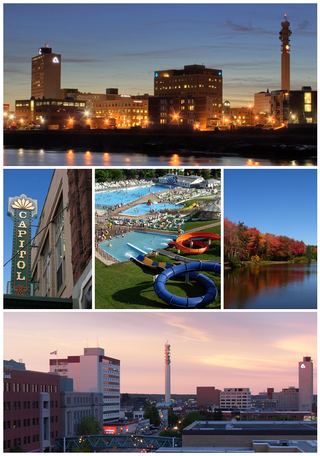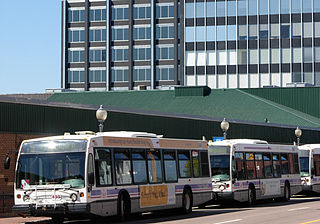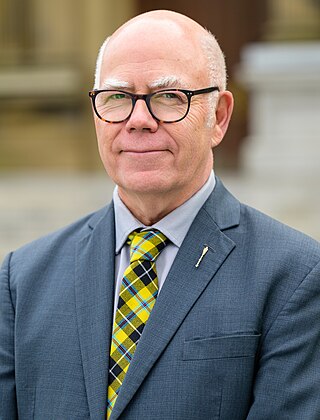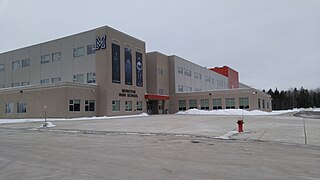
Moncton is the most populous city in the Canadian province of New Brunswick. Situated in the Petitcodiac River Valley, Moncton lies at the geographic centre of the Maritime Provinces. The city has earned the nickname "Hub City" because of its central inland location in the region and its history as a railway and land transportation hub for the Maritimes. As of the 2021 Census, the city had a population of 79,470. The metropolitan population in 2022 was 171,608, making it the fastest growing CMA in Canada for the year with a growth rate of 5.3%. Its land area is 140.67 km2 (54.31 sq mi).

Campbellton is a city in Restigouche County, New Brunswick, Canada.

Louis Joseph Robichaud, popularly known as "Little Louis" or "P'tit-Louis", was the second Acadian premier of New Brunswick, serving from 1960 to 1970.

Shawn Michael Graham is a Canadian politician, who served as the 31st premier of New Brunswick from 2006 to 2010. He was elected leader of the New Brunswick Liberal Party in 2002 and became premier after his party captured a majority of seats in the 2006 election. After being elected, Graham initiated a number of changes to provincial policy especially in the areas of health care, education and energy. His party was defeated in the New Brunswick provincial election held September 27, 2010, and Graham resigned as Liberal leader on November 9, 2010.
New Brunswick Community College (NBCC) is a public college located throughout various locations in New Brunswick, Canada, including Moncton, Miramichi, Fredericton, Saint John, St. Andrews, and Woodstock.
Kelly Lamrock is a lawyer and political consultant in the province of New Brunswick, Canada. He was previously a Liberal member of the Legislative Assembly of New Brunswick for Fredericton-Fort Nashwaak, and Minister of Social Development in the New Brunswick cabinet before opening Lamrock's Law in Fredericton.
Bernice MacNaughton High School is a high school in Moncton, New Brunswick, Canada.

École L'Odyssée is a public francophone high school in Moncton, New Brunswick, Canada. It is part of the province's Francophone Sud School District, offering education to students from grade nine to twelve. The school opened on September 30, 2005 as part of a $24.2 million project, alongside the adjoining middle school, École Le Mascaret. École L'Odyssée was conceived as a way to alleviate the overcrowding problem at École Mathieu-Martin in nearby Dieppe, a problem the district has had in the past. The Odyssée-Mascaret project, as well as the future Carrefour de l'Acadie middle school, replaced the former École Beauséjour and École Vanier complexes. This move allowed the Moncton Hospital to expand, while the Vanier establishment made way for medical offices. On September 9, 2009, the school was given permission to begin an $884,000 expansion for its far side, allowing for a larger space to be reserved for its infirmary and orientation center.

Higher education in New Brunswick refers to education provided by higher education institutions in the Canadian province of New Brunswick. Higher education has a rich history in New Brunswick. The first English-language university in Canada was the University of New Brunswick. Mount Allison University was the first in the British Empire to award a baccalaureate to a woman, Grace Annie Lockhart, B.Sc. in 1875. Education is the responsibility of the provinces in Canada and there is no federal ministry governing it.

Codiac Transpo, officially Codiac Transit Commission, is the urban transit service of the City of Moncton, operated on behalf of Moncton, the City of Dieppe, and the Town of Riverview in New Brunswick, Canada. The transit system provides local bus service for the residents of the Greater Moncton area and charter service throughout the southeastern area of the province. New charter services are currently suspended as Codiac Transpo obtains more buses but existing obligations are still taking place. Maritime-wide bus service is provided by private company Maritime Bus.
Turtle Creek is a Canadian creek in Albert County, southeastern New Brunswick. The creek drains a watershed area of 192 square kilometres, and is the primary source of potable water for Moncton, Riverview, and Dieppe, thanks to the 150 km2 (58 sq mi) Turtle Creek reservoir and the Moncton Water Treatment Plant.

David Charles Coon is a Canadian conservationist and politician who has served as leader of the Green Party of New Brunswick since 2012 and as a Member of the Legislative Assembly of New Brunswick for Fredericton South since 2014.

Brian Alexander Gallant is a Canadian retired politician who served as the 33rd premier of New Brunswick from October 7, 2014, until November 9, 2018. Of Acadian and Dutch descent, Gallant practised as a lawyer before winning the Liberal leadership in October 2012, securing the riding of Kent in a by-election on April 15, 2013, shortly followed by his swearing in as Leader of the Opposition. After the 2014 election, in which the Progressive Conservative government of David Alward was defeated, Gallant was sworn in as Premier at the age of 32.

Moncton High School is a Canadian secondary school in Moncton, New Brunswick and a part of the Anglophone East School District. The school received the students from the former Moncton High School on January 30, 2015.
The education system of New Brunswick comprises public and private primary and secondary schools and post-secondary institutions. By the British North America Act, 1867, education falls entirely under provincial jurisdiction. There is no federal government department or agency involved in the formation or analysis of policy regarding education. Also by constitutional right, Roman Catholics are entitled to their own school system; this led in New Brunswick to contention in the early years of the nation, and, in 1871, to the first case sent from Canada to the Judicial Committee of the Privy Council, Maher v Town Council of Portland.
The Centennial Building is an office building in downtown Fredericton, New Brunswick. Opened in March 1967, it was the province of New Brunswick's official Centennial project. At six storeys and 250,000 square feet (23,000 m2), it was designed to accommodate over 1000 provincial civil servants, who had been dispersed in more than 20 separate buildings in Fredericton, the province's capital city.

The Canadian province of New Brunswick is divided into 89 local entities, consisting of 77 local governments and 12 rural districts.











